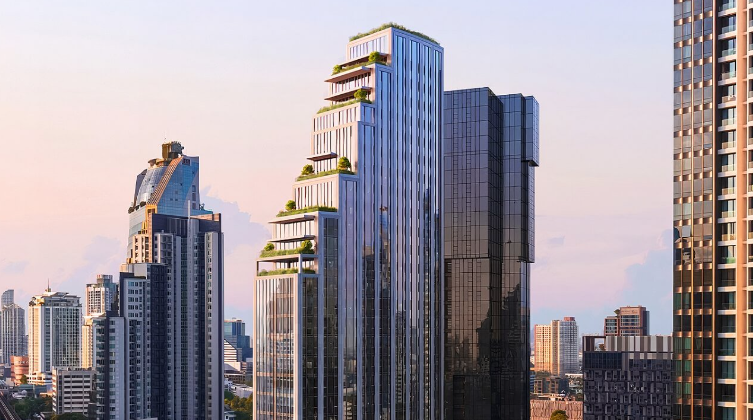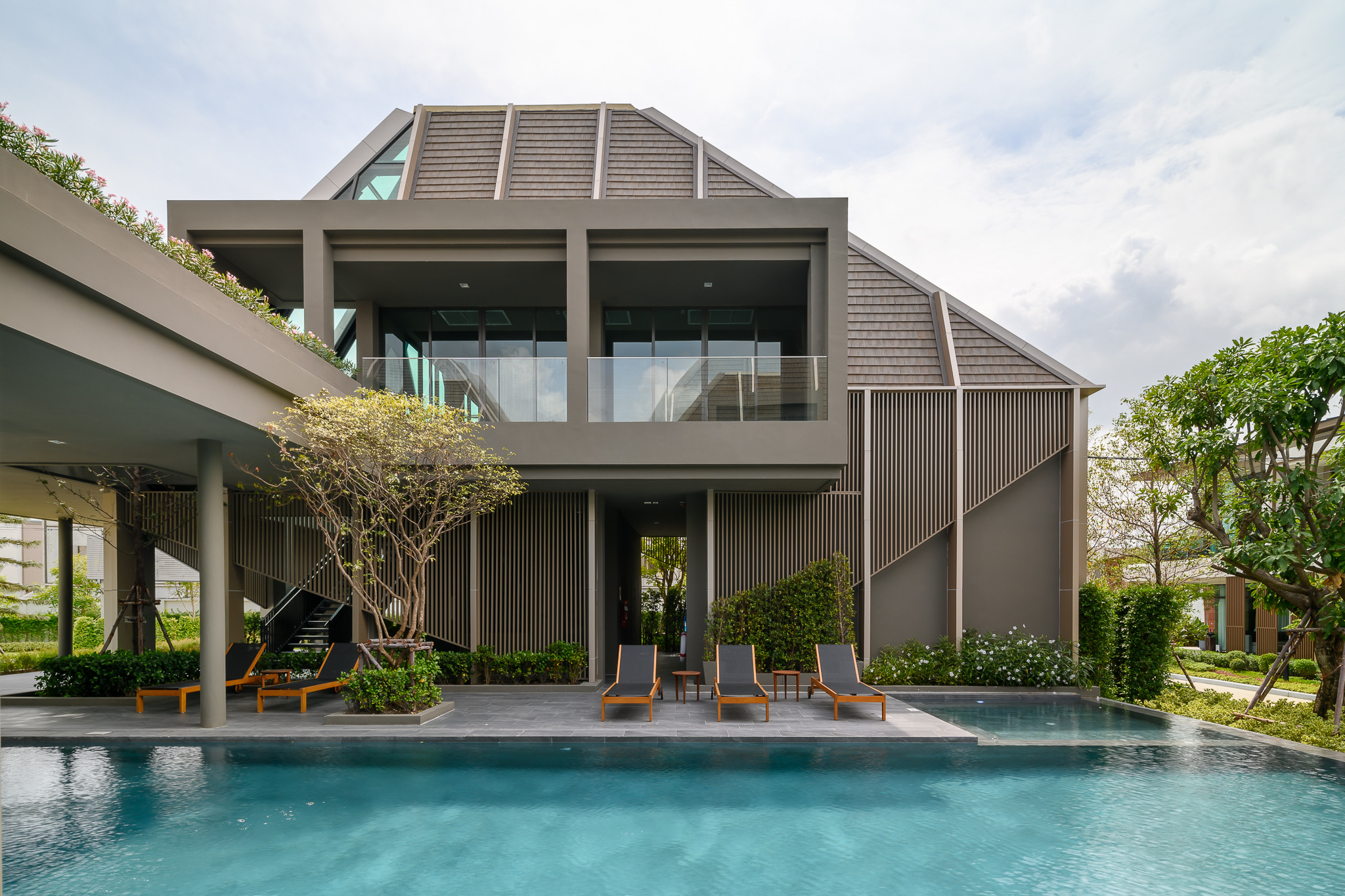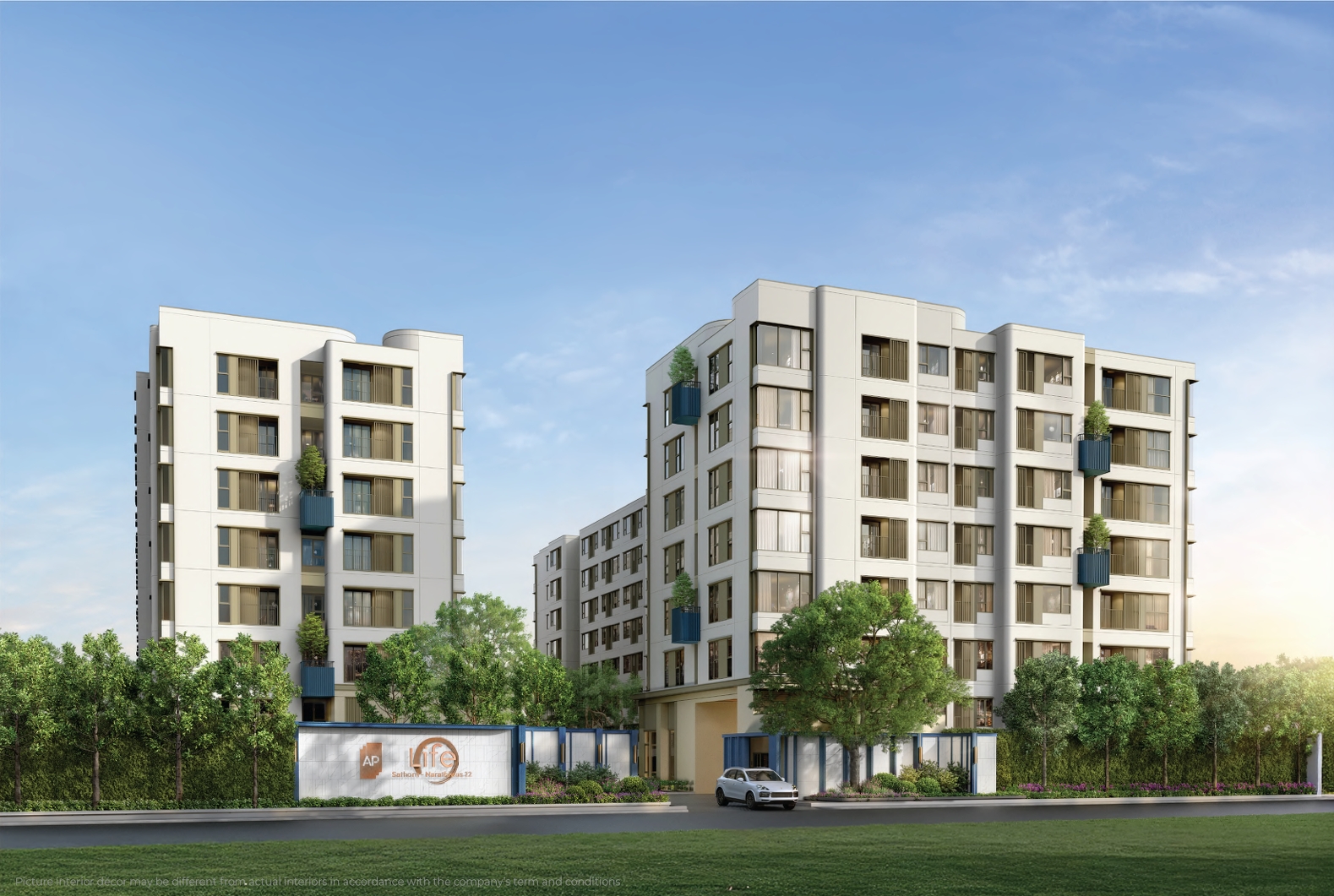When Buildings Shake But Money Stays Firm: What Properties Gained Value After the Bangkok Quake?
这几天,曼谷的朋友圈都在聊一件事——“你家晃了吗?”就在前一天,缅甸发生了7.9级强震,曼谷实测达到4.7级,几乎所有高层住户都感受到了“楼在跳舞”,空中泳池直接上演“泼水节”,人心一时间也被搅得七上八下。
Lately, there’s one question circling Bangkok's social media: "Did your building sway?" Just a day ago, a 7.9-magnitude earthquake struck Myanmar, with tremors in Bangkok reaching a measured magnitude of 4.7. Nearly all residents in high-rises felt the buildings "dancing", rooftop pools splashing like it was Songkran, and nerves were shaken citywide.

但让人意外的是,这座遍布摩天大楼的城市,在剧烈晃动中并没有发生楼体倒塌的情况。30层、40层的建筑依旧笔直挺立,地震过后的第二天,街头恢复如常,写字楼正常上班,商场照常营业。大家心头那根紧绷的弦,似乎被悄悄放松了几分。
Yet surprisingly, despite Bangkok being a skyline of towering buildings, none of them collapsed in the strong shaking. Buildings with 30 or even 40 floors stood tall and steady. By the next day, everything had returned to normal—offices reopened, malls were back in business, and the collective tension had eased.
有人说是“佛祖保佑”,也有人说“曼谷命大”,但更值得深思的,是这次地震其实给了曼谷楼市一次突如其来的“实测机会”——它没有倒,但我们该认真问问自己:到底是运气,还是实力?
Some say it was "Buddha’s blessing", others joked it was "Bangkok’s luck", but what’s truly worth pondering is this: the quake became an unexpected real-world test for the city’s property market. No collapse occurred—but was that pure luck, or real strength?
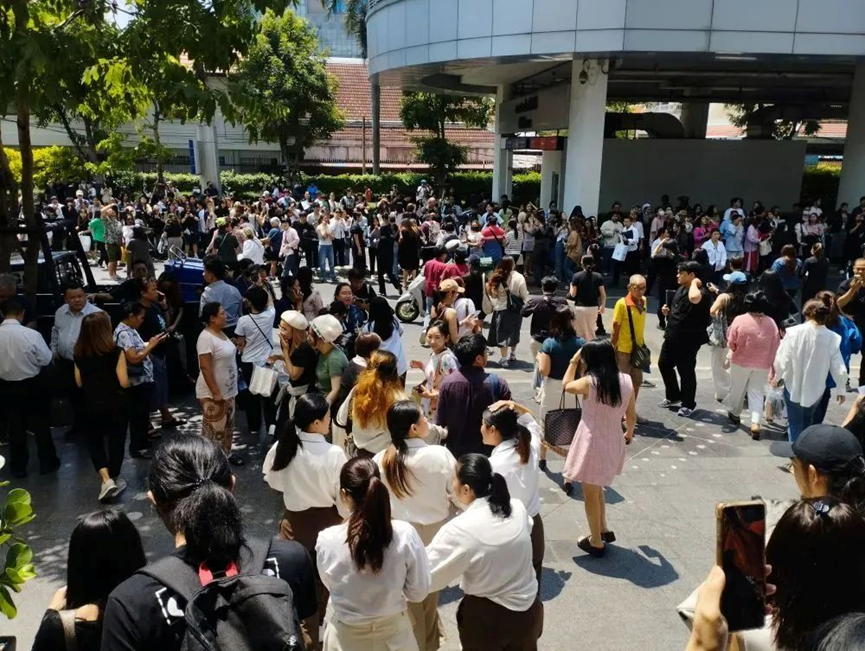
官方报告来了,建筑安全吗?
Official Reports: Are the Buildings Safe
就在人们还在群里讨论“家里晃了几秒”的时候,泰国官方已经迅速出动了。4月1日,内政部公共工程与城乡规划部联合110名专业工程志愿者,对三大类建筑进行了全面检测。
While residents were still debating “how many seconds their house shook,” the Thai government acted quickly. On April 1, the Department of Public Works and Town & Country Planning dispatched 110 professional engineering volunteers to inspect three key building types.
首先是医院、学校、政府大楼这些重点场所,总共81栋建筑中,76栋毫无大碍,5栋虽有些许损伤但仍可使用,严重损毁的一个都没有。接下来是酒店、公寓、商场等民用高楼,虽然检测仍在继续,但多数建筑都能“继续服役”。
First were critical facilities like hospitals, schools, and government buildings. Of the 81 structures inspected, 76 had no issues, five had minor damage but remained usable, and none were severely affected. Civilian buildings like hotels, condominiums, and shopping malls are still under review, but most are deemed safe for continued use.
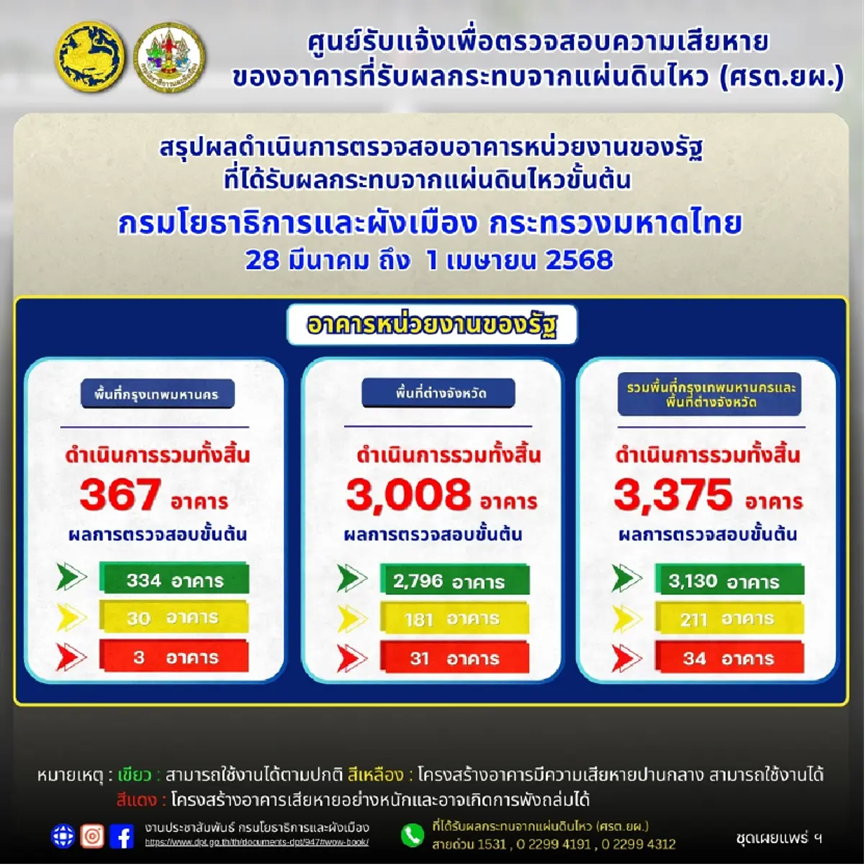
最引人关注的是普通人住的住宅区——包括联排别墅、店屋、低层公寓等。在超过3000栋已检查的住宅中,绝大多数都被打上了“绿灯”标签,只有极少数被勒令暂停使用。
The spotlight, however, was on residential neighborhoods—townhouses, shophouses, and low-rise apartments. Out of over 3,000 homes inspected so far, the overwhelming majority received a “green light,” with only a handful ordered to pause occupancy.
一轮专业检测下来,不少人都松了口气——原来那些在地震中晃个不停的楼,其实没有真的“伤筋动骨”。这不只是政府的应对速度快,更说明了泰国城市建筑的抗震能力,确实有点底子。
This round of professional checks brought collective relief. The buildings that swayed during the quake hadn’t actually suffered structural damage. This not only showed the government's rapid response, but also validated the seismic resilience of Thai urban construction.
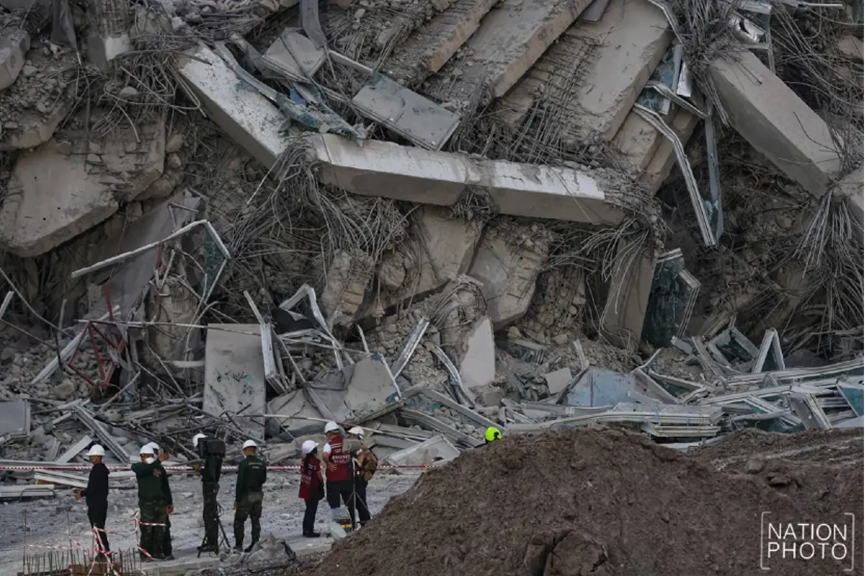
泰国房地产,天生就“抗震”
Built to Resist Quakes by Nature
其实要说曼谷这次稳住了,不光是靠运气,更多是它本身“地震体质”就比较硬核。
Bangkok’s stability during the quake was not just luck—it was backed by structural resilience.
先从地理说起。泰国不像邻国缅甸或印尼那样,正好卡在地震带上。整个国家地处稳定的中南半岛中部,特别是曼谷,压根离主要活动断层和俯冲带有一大截距离。从历史来看,1912年到现在,泰国本土的地震几乎都不超过5级,这样的“地震记录”在东南亚堪称优等生。
Starting with geography: unlike Myanmar or Indonesia, Thailand doesn’t sit directly on a seismic fault line. The country lies in the relatively stable central Indochinese peninsula. Especially for Bangkok, it's far from active fault zones and subduction areas. Historically, Thailand hasn’t seen earthquakes stronger than magnitude 5 since 1912, making it one of Southeast Asia’s best performers in seismic terms.

但泰国并没有因为震少就掉以轻心。2007年起,政府就陆续推出了多套抗震设计标准和建筑规范,特别是对高层建筑、南部沿海和北部山区,要求相当严格——结构要灵活、地基要加固、关键部位必须抗震8级以上。这也意味着,哪怕真的来大震,建筑能顶得住的可能性也更高。
Yet Thailand hasn’t been complacent. Since 2007, the government has implemented strict seismic building codes, especially for high-rises, coastal regions, and mountainous northern areas. Requirements include flexible structural designs, reinforced foundations, and earthquake resistance up to magnitude 8. This means that even in the face of stronger quakes, buildings are more likely to hold up.
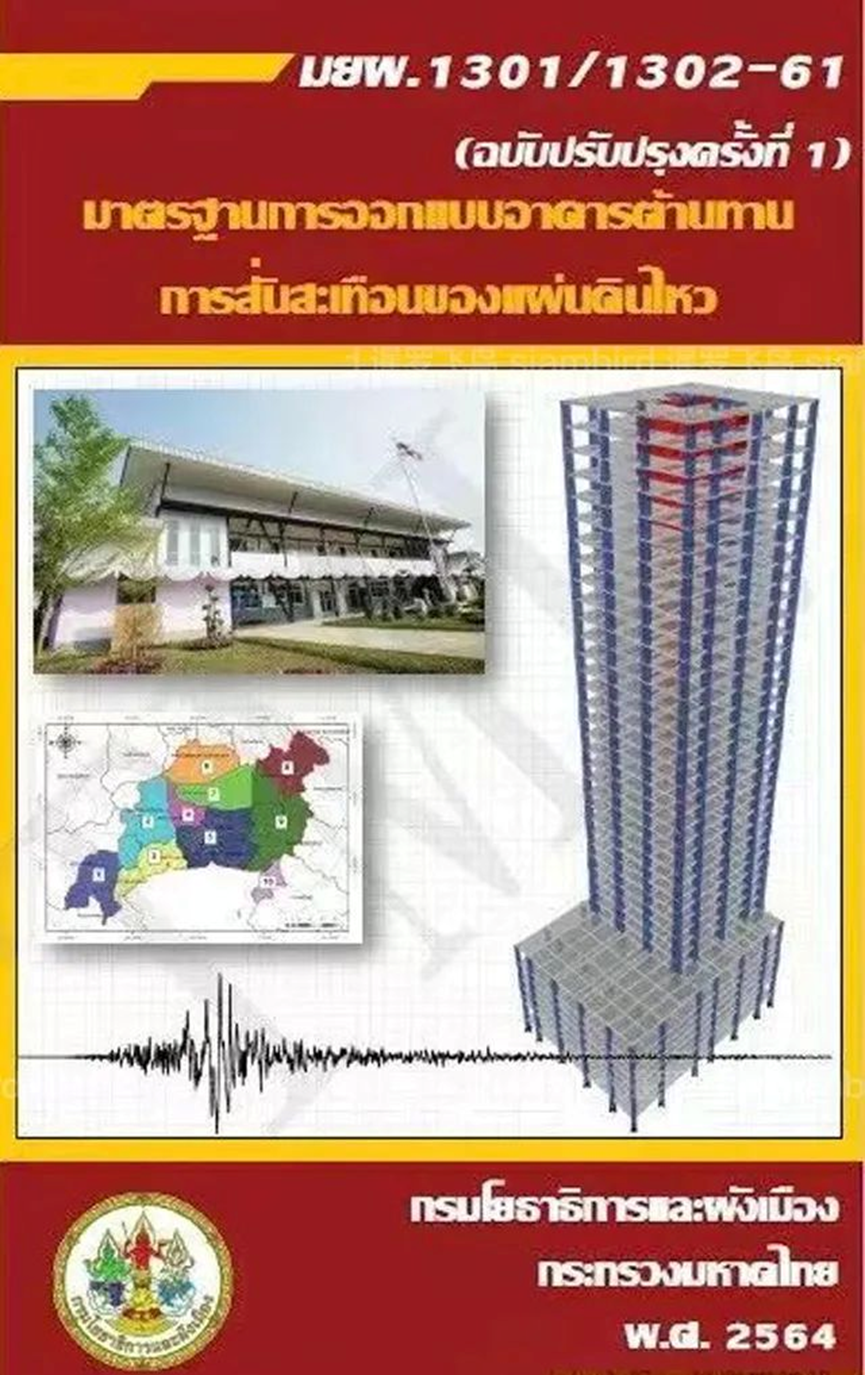
还有一个更实在的支撑点是“过往没有大地震”这个事实。过去一百多年,泰国从未发生过类似邻国那种严重房屋倒塌或海啸后的城市毁灭事件。就拿这次来说,曼谷感受到4.7级震感,这已经是它500年来“最强一次”了。
Adding to that is the country’s track record: in the past century, Thailand hasn’t experienced catastrophic building collapses or tsunami devastation like its neighbors. In fact, Bangkok’s 4.7-magnitude shake was the strongest in 500 years.
换句话说,曼谷这城市虽然晃得厉害,但在地震风险这件事上,它就是天生“自带减震器”。
In short, while Bangkok certainly swayed, the city seems to come equipped with a natural “shock absorber” when it comes to earthquake risks.
盲投的教训,暴露出这些问题
Lessons from the Quake: What Got Exposed?
虽然官方报告看起来还算安心,但这场地震,确实也像一面镜子,把一些平时被忽略的问题照了个清楚。
Although the official reports were reassuring, the earthquake acted as a mirror, reflecting long-ignored issues.
比如,有些老旧建筑摇晃得格外明显,墙面出现裂痕、门窗变形——这些建筑往往不是出自大品牌开发商,甚至连抗震标准都不完全合规。而一些看起来挺新的公寓,也暴露出基础结构处理不到位的问题,地震一来就“骨架软”,吓得住户连夜搬家。
Older buildings swayed more noticeably, some showing cracks or misaligned doors and windows—often structures not built by top-tier developers or those that didn’t meet modern seismic standards. Even some seemingly newer condos revealed weak foundational structures, prompting residents to evacuate in fear.
这次还有不少投资者开始反思:当初买房是不是太冲动了?有人是因为“楼盘宣传图好看”就拍板了,有人只看楼层高低、地段热不热,却忽略了开发商背景和建筑质量。尤其是一些“网红盘”,打着景观噱头卖到三四十层,但真正面对地震考验时,心理压力远大于实际价值。
Many investors are now re-evaluating their decisions: were those purchases too impulsive? Some were swayed by flashy promotional renderings, others prioritized floor level and location while ignoring developer reputation or construction quality. “Insta-famous” skyscraper projects, often marketed for their scenic views, turned out to bring more anxiety than real value during a quake.
而反过来,那些挑选稳健项目、选对开发商、看重建筑本身安全性能的买家,就显得特别冷静——不光没受影响,还有人开始接到出租需求、报价上涨的消息。
In contrast, those who chose projects based on sound fundamentals—trustworthy developers, solid safety ratings—are now seeing rising rental interest and even price bumps.
这一震,像是给整个楼市来了一场“实地筛查”,让人开始意识到:不是所有楼都一样,盲投带来的不确定性,才是最大的风险。
This quake has essentially served as a “live audit” for the property market, reminding everyone that not all buildings are created equal. The greatest risk lies in blind investment.
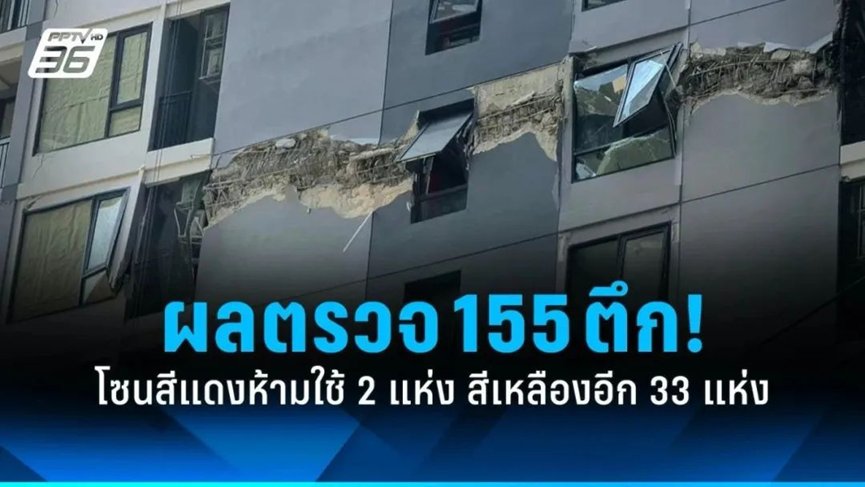
震后突围,这些房型成香饽饽
Which Homes Are Gaining Popularity?
震后一周,有人忙着检查墙角裂缝,有人却已经开始看房了——而这一次,大家的关注点明显发生了变化。
One week after the quake, while some residents are still checking their walls for cracks, others have started house hunting—with a noticeable shift in what they’re looking for.
以往热度最高的是市中心的高层公寓,视野好、配套全、租金也高,但这次地震之后,很多人开始掉头去看那些更“贴地气”的房型:比如8层以下的小公寓、占地面积大的联排别墅,还有最受关注的独栋住宅。
Previously, the hottest properties were central high-rises with panoramic views and full amenities. But after this quake, many buyers are turning their attention to more “down-to-earth” housing: low-rise condos under 8 floors, spacious townhouses, and most notably, standalone homes.

为什么这类房型突然吃香了?原因很简单:安全感。
Why the sudden interest in these types? One word: safety.
相比动辄三四十层的塔楼,这些建筑结构更简单、重心更低、设计更稳定,即使地震来袭,晃动感更弱,心理压力也更小。很多联排或独栋住宅还带有庭院、车位、独立水电系统,在紧急状况下的自给自足能力也更强。
Compared to skyscrapers with 30 or 40 floors, low-rise buildings offer simpler structures, lower centers of gravity, and more stability. They shake less and cause less psychological stress. Many townhouses and standalone homes also come with yards, parking spaces, and independent utility systems—features that allow for better self-sufficiency during emergencies.
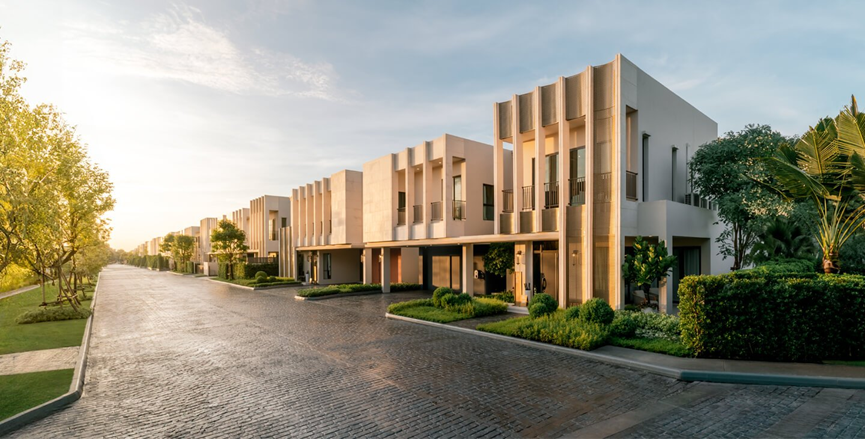
在这场“楼在晃,人心也晃”的地震之后,买家的选择逻辑已经变了。尤其是那些有孩子、带长辈的家庭,或者打算自住的人群,更倾向于用真金白银换一个安心的生活空间。
After this episode of "buildings shaking and nerves shaking harder," buyer preferences are shifting. Families with kids or elderly parents, or those planning to live long-term, are now willing to pay more for peace of mind.
而这种低密度、安全性高、数量又不多的房型,一旦被市场集体关注,价格自然水涨船高。有业内人士直言:“不是地震让这些房子变贵了,而是这次终于有人看清了它们的价值。”
With these low-density, high-safety, and limited-supply housing types now in the spotlight, price increases seem inevitable. As one industry insider put it: “It’s not the earthquake that made them more valuable—it’s that people finally saw their value.”
震后抄底?给你个判断标准
Buying the Dip? Here’s How to Judge
每次市场有波动,总有人问:“是不是抄底的机会来了?”
Every time the market shifts, someone asks: "Is now the time to buy the dip?"
坦白说,这次地震的确让一些区域价格松动,部分急售房源开始出现,但这并不等于“闭眼就能捡漏”。真正聪明的投资者,不是看价格低就冲,而是看风险与潜力的平衡点在哪里。
Truthfully, the quake has led to price softening in some areas, with motivated sellers popping up. But that doesn’t mean bargains are guaranteed. The smart investors aren’t just looking for discounts—they’re seeking the right balance between risk and potential.
比如,那些本就供应稀缺、又在这次震后表现稳健的低密住宅,哪怕短期没降价,反而是更值得考虑的长期标的。而一些名不见经传、施工质量存疑的高层公寓,即便打折再狠,也可能埋着“维修隐患”这颗雷。
For example, low-density homes that are both scarce in supply and performed well during the quake are worth considering, even if their prices haven’t dropped. Meanwhile, lesser-known high-rises with questionable build quality might look cheap now, but could harbor expensive repair issues down the line.

更重要的是,要看开发商是谁。震后最先被信任、最快响应、最早复工的,几乎全是大品牌的项目。在市场不稳的时候,品牌的保障力,才是真正的安全垫。
And above all, look at the developer. Projects by reputable, fast-responding, and well-organized developers have earned public trust post-quake. In uncertain times, brand reputation becomes your real safety net.
所以问题不在于“能不能抄底”,而是你抄的是坑,还是价值洼地。
So the real question isn’t whether to buy the dip, but what you’re buying: a value opportunity, or a potential money pit?
总结来说,曼谷楼市并没有因为这场地震崩塌,反而经历了一次信心与品质的洗牌。对投资者而言,这是一次重新排队的机会;对开发商来说,谁做得更好,市场自然会给出答案。
In summary, Bangkok’s property market didn’t crumble with the earthquake. Instead, it went through a re-shuffling of trust and quality. For investors, this is a chance to reassess the lineup; for developers, the market will speak for itself.
现在不是乱买的时候,但正是该认真做功课的时候。
Now isn’t the time to buy recklessly—but it is the time to do your homework.


